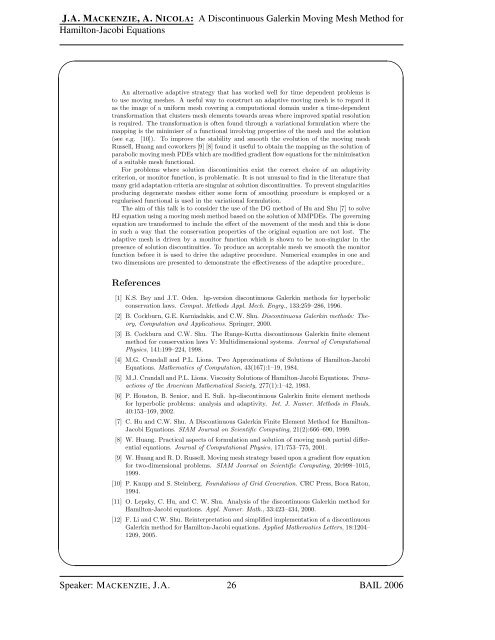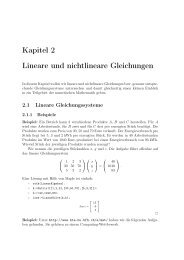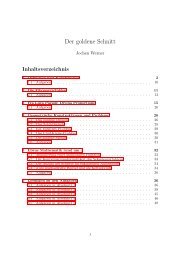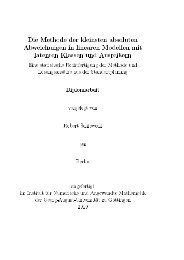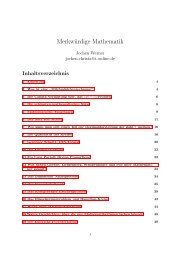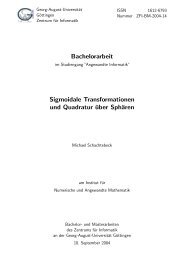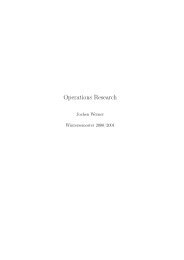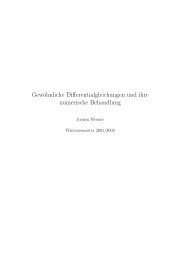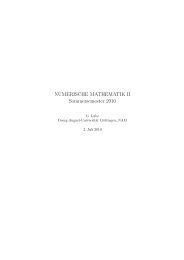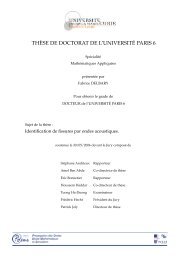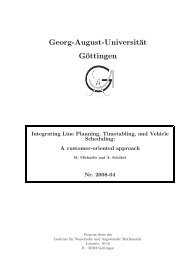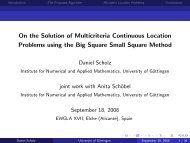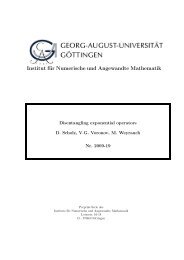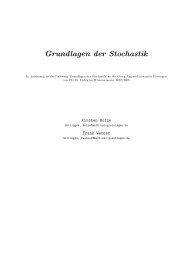BAIL 2006 Book of Abstracts - Institut für Numerische und ...
BAIL 2006 Book of Abstracts - Institut für Numerische und ...
BAIL 2006 Book of Abstracts - Institut für Numerische und ...
You also want an ePaper? Increase the reach of your titles
YUMPU automatically turns print PDFs into web optimized ePapers that Google loves.
J.A. MACKENZIE, A. NICOLA: A Discontinuous Galerkin Moving Mesh Method for<br />
Hamilton-Jacobi Equations<br />
✬<br />
✫<br />
An alternative adaptive strategy that has worked well for time dependent problems is<br />
to use moving meshes. A useful way to construct an adaptive moving mesh is to regard it<br />
as the image <strong>of</strong> a uniform mesh covering a computational domain <strong>und</strong>er a time-dependent<br />
transformation that clusters mesh elements towards areas where improved spatial resolution<br />
is required. The transformation is <strong>of</strong>ten fo<strong>und</strong> through a variational formulation where the<br />
mapping is the minimiser <strong>of</strong> a functional involving properties <strong>of</strong> the mesh and the solution<br />
(see e.g. [10]). To improve the stability and smooth the evolution <strong>of</strong> the moving mesh<br />
Russell, Huang and coworkers [9] [8] fo<strong>und</strong> it useful to obtain the mapping as the solution <strong>of</strong><br />
parabolic moving mesh PDEs which are modified gradient flow equations for the minimisation<br />
<strong>of</strong> a suitable mesh functional.<br />
For problems where solution discontinuities exist the correct choice <strong>of</strong> an adaptivity<br />
criterion, or monitor function, is problematic. It is not unusual to find in the literature that<br />
many grid adaptation criteria are singular at solution discontinuities. To prevent singularities<br />
producing degenerate meshes either some form <strong>of</strong> smoothing procedure is employed or a<br />
regularised functional is used in the variational formulation.<br />
The aim <strong>of</strong> this talk is to consider the use <strong>of</strong> the DG method <strong>of</strong> Hu and Shu [7] to solve<br />
HJ equation using a moving mesh method based on the solution <strong>of</strong> MMPDEs. The governing<br />
equation are transformed to include the effect <strong>of</strong> the movement <strong>of</strong> the mesh and this is done<br />
in such a way that the conservation properties <strong>of</strong> the original equation are not lost. The<br />
adaptive mesh is driven by a monitor function which is shown to be non-singular in the<br />
presence <strong>of</strong> solution discontinuities. To produce an acceptable mesh we smooth the monitor<br />
function before it is used to drive the adaptive procedure. Numerical examples in one and<br />
two dimensions are presented to demonstrate the effectiveness <strong>of</strong> the adaptive procedure..<br />
References<br />
[1] K.S. Bey and J.T. Oden. hp-version discontinuous Galerkin methods for hyperbolic<br />
conservation laws. Comput. Methods Appl. Mech. Engrg., 133:259–286, 1996.<br />
[2] B. Cockburn, G.E. Karniadakis, and C.W. Shu. Discontinuous Galerkin methods: Theory,<br />
Computation and Applications. Springer, 2000.<br />
[3] B. Cockburn and C.W. Shu. The Runge-Kutta discontinuous Galerkin finite element<br />
method for conservation laws V: Multidimensional systems. Journal <strong>of</strong> Computational<br />
Physics, 141:199–224, 1998.<br />
[4] M.G. Crandall and P.L. Lions. Two Approximations <strong>of</strong> Solutions <strong>of</strong> Hamilton-Jacobi<br />
Equations. Mathematics <strong>of</strong> Computation, 43(167):1–19, 1984.<br />
[5] M.J. Crandall and P.L. Lions. Viscosity Solutions <strong>of</strong> Hamilton-Jacobi Equations. Transactions<br />
<strong>of</strong> the American Mathematical Society, 277(1):1–42, 1983.<br />
[6] P. Houston, B. Senior, and E. Suli. hp-discontinuous Galerkin finite element methods<br />
for hyperbolic problems: analysis and adaptivity. Int. J. Numer. Methods in Fluids,<br />
40:153–169, 2002.<br />
[7] C. Hu and C.W. Shu. A Discontinuous Galerkin Finite Element Method for Hamilton-<br />
Jacobi Equations. SIAM Journal on Scientific Computing, 21(2):666–690, 1999.<br />
[8] W. Huang. Practical aspects <strong>of</strong> formulation and solution <strong>of</strong> moving mesh partial differential<br />
equations. Journal <strong>of</strong> Computational Physics, 171:753–775, 2001.<br />
[9] W. Huang and R. D. Russell. Moving mesh strategy based upon a gradient flow equation<br />
for two-dimensional problems. SIAM Journal on Scientific Computing, 20:998–1015,<br />
1999.<br />
[10] P. Knupp and S. Steinberg. Fo<strong>und</strong>ations <strong>of</strong> Grid Generation. CRC Press, Boca Raton,<br />
1994.<br />
[11] O. Lepsky, C. Hu, and C. W. Shu. Analysis <strong>of</strong> the discontinuous Galerkin method for<br />
Hamilton-Jacobi equations. Appl. Numer. Math., 33:423–434, 2000.<br />
[12] F. Li and C.W. Shu. Reinterpretation and simplified implementation <strong>of</strong> a discontinuous<br />
Galerkin method for Hamilton-Jacobi equations. Applied Mathematics Letters, 18:1204–<br />
1209, 2005.<br />
Speaker: MACKENZIE, J.A. 26 <strong>BAIL</strong> <strong>2006</strong><br />
✩<br />
✪


